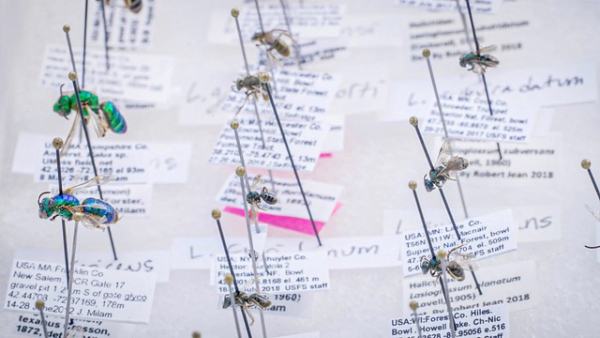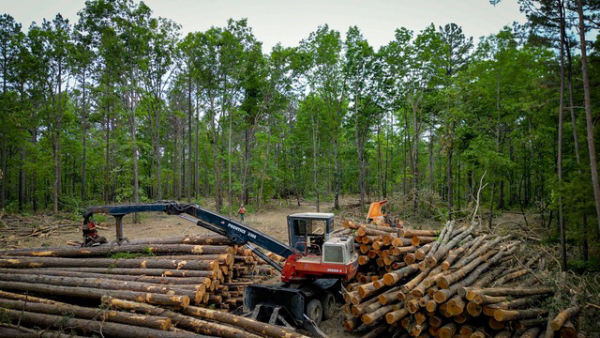Managing Forests – for Bees
June 26, 2023 — Most people are acquainted with honeybees and bumblebees and their importance in nature. There are 4,000 bee species in this country that pollinate 80 percent of all flowering plants, including more than 130 types of fruits and vegetables. In fact, every year, they pollinate $15 billion worth of U.S. crops, the very food we eat.

Despite their critical role in nature and the economy, bee populations continue to decline in range and abundance. One of the major causes of pollinator decline is habitat loss. That is why Forest Service scientists at the Northern Research Station created the Pollinator Habitat in Log Landings Project. The project is a three-year study on developing pollinator habitat on log landings (places where loggers stack, sort, and load timber into trucks) following timber harvests. “What we’re doing on national forests is really to benefit a diverse range of flora and fauna,” said Lauren Pile Knapp, research ecologist. “And this project is just one piece of that.”
“The project was brought to us by [land] managers …to really work through some problem-solving exercises to see if we could rapidly create ephemeral pollinator habitats on these highly degraded sites to be able to provide floral resources for native pollinators,” added Pile Knapp.

Trees are removed from national forests for a variety of reasons, including meeting the nation’s timber needs, as well as protecting and restoring ecological systems, such as restoring oak. The logging trucks and piles of logs waiting to be transported can compact soil and impact vegetation in a small area of the forest.
“So, we’re harvesting timber, we’re getting a product out of that,” said Pile Knapp. “But by doing that, we’re also creating habitat for birds and bees.”
Traditionally, the Forest Service plants annual wheat or annual rye to avert runoff and reduce sedimentation. However, those grains are not attractive to pollinators, and the time between tree harvesting and planting seedlings can be lengthy.
So, Pile Knapp and other scientists set up an outdoor lab on the Hoosier National Forest in Indiana, the Shawnee National Forest in Illinois, and the Mark Twain National Forest in Missouri.

On the Hoosier, for example, plantings for pollinators faced limitations because of soil compaction, low soil fertility, erosion, residual mulch and logging debris, and competition from fast-growing non-native invasive plants.
“There were many different combinations of treatments that we could examine and look at, but we needed to narrow the focus,” said John Kabrick, research forester.
So, they decided to focus on five log landings that would receive treatment and, for comparison, five that would be allowed to revegetate naturally on each forest. The treatments examined the effects of subsoiling treatment and amending the soil using biochar. The subsoiling treatment lifts the soil and breaks up compaction. Biochar, a lightweight, high-carbon substance, helps soil absorb water and hold nutrients.
On each of the five treated landings, the scientists compared using subsoiling treatment alone, using biochar application alone, and combining both biochar application and subsoiling treatment. In the combination treatment, the subsoiler incorporated biochar into the soil. This causes it to go deeper into the soil more quickly than waiting for freeze-thaw or wet-dry cycles to move it downward. Each landing also had a control where no treatment was applied. A native pollinator seed mix was applied to half of each treatment.
The team recognized that each of these treatments was of great interest to managers and scientists. The question is which treatment is the most effective, Kabrick said. “What we’re looking for is something that we can recommend as a best management practice.”
The scientists removed mulch and excess logging debris and installed erosion control measures for all treated and untreated plots. The introduction of biochar has proven in other places to increase vegetation growth, improve soil health and soil condition across a range of ecological systems, and is associated with reductions in invasive plant species. The pollinator seed mix selected for the experiments includes native flora that are adapted to a wide range of site conditions.
“Active forest management can enrich bee communities by enhancing floral resources for pollen and nectar, by providing dead wood and bare ground for important nesting habitat,” Pile Knapp said. “These are very small little patches, but if you multiply them across the landscape, we’re really creating a difference for pollinators.”
(Thanks to the Northern Research Station, Hoosier National Forest, Shawnee National Forest, and Mark Twain National Forest for their help in developing this story.)
— Preston Keres, USDA






